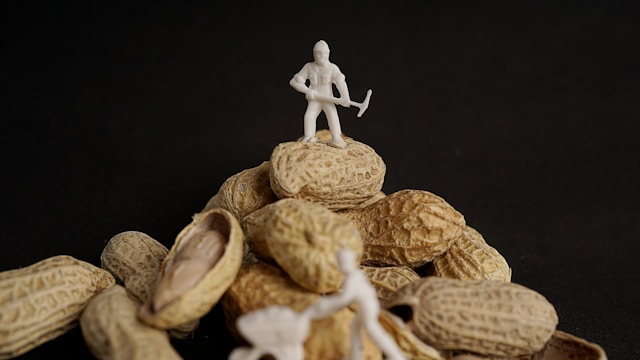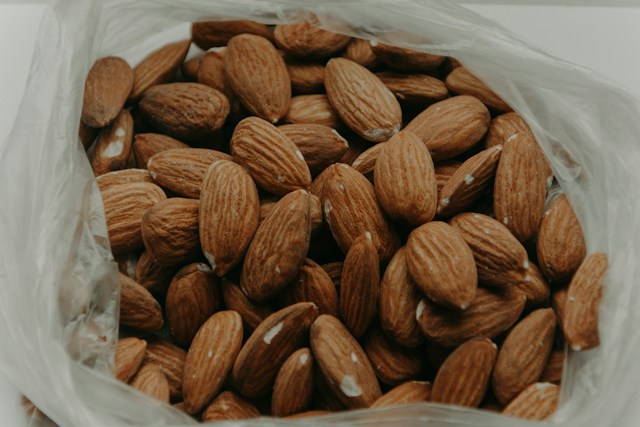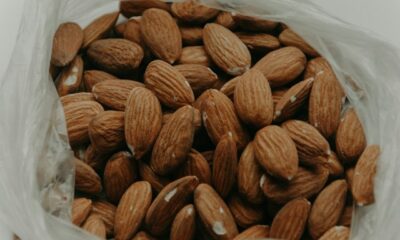Nutrition
Almond Milk Nutrition – It’s time to repent!

One excellent substitute for dairy products (i.e. milk) was the unlikely substitute of almond milk…
Almond Milk Nutrition Benefits
As all of you might be aware, almond milk comes from the drupe (not nut) known as the almond and is a popular source of nutrition in countries in the Middle East as well as Asia for numerous reasons.
In India, the Ayurveda system believed that almonds are excellent brain-food while in China, it is considered to be a symbol of female beauty. But there are a host of benefits to consuming this drupe, and so here is a list of benefits that can enjoyed, especially in the form of almond milk nutrition:
1) Almonds are rich in Vitamin E, an antioxidant, which is excellent for neutralizing harmful free radicals in our body.
2) Lowers the risk of heart attacks, drops bad cholesterol levels and helps in weight loss due to its high unsaturated fat levels.
3) With a light, nutty and crisp taste, almond milk is considered to be the best alternative for those with lactose intolerance, and who aren’t so fond of the taste of milk (but not necessarily allergic to it).
4) In comparison to milk (which is 86 calories), a glass of almond milk is about 70 calories. So it works as a perfect drink for those who are conscious of the number of calories that they are consuming.
5) Amazingly, it lasts much longer than milk and doesn’t need to be refrigerated, which was why it was a popular option during the Lent season.
How to Prepare Almond Milk
Very simply, it’s very easy to make . The ingredients that you need are just a cup of almonds and 4 cups of water.
Here are the steps that can be followed in order to prepare almond milk:
Step 1: Add 4 cups of water to the cup of almonds, and cover it with a lid.
Step 2: Refrigerate the container for 1-2 days.
Step 3: Next, blend the mixture of almonds and water until you get a smooth mixture.
Step 4: Use a cheesecloth to strain the smooth mixture obtained.
Step 5: Go ahead and drink like you would drink normal milk or use it for several dishes and other preparations that you can make normally.
In Closing
And I wonder what will happen if this friend had to live in the Middle Ages – it would truly be a time to repent!
Nutrition
Sous Vide Tri Tip: The Foolproof Method for Delicious Results Every Time

Picture this: a succulent cut of tri tip steak, perfectly cooked to tender, juicy perfection every time. How is this culinary magic achieved, you ask? The answer lies in the art of sous vide cooking. In this blog post, we will dive into the world of sous vide tri tip and uncover the secrets to creating a melt-in-your-mouth dining experience that will have your taste buds dancing with delight. So grab your apron and get ready to elevate your steak game to new heights!
What is Sous Vide Cooking?
Sous vide cooking, a culinary technique that has taken the food world by storm, involves sealing food in airtight bags and cooking it in a temperature-controlled water bath. The term “sous vide” is French for “under vacuum,” highlighting the method’s focus on precise temperature control.
By cooking at lower temperatures for extended periods, sous vide allows for even doneness from edge to edge, resulting in tender and flavorful meats. This gentle cooking process helps retain moisture and juices while enhancing the natural flavors of the ingredients.
One of the key advantages of sous vide is its consistency – you can achieve perfectly cooked results every time with minimal effort. Whether you’re a novice home cook or a seasoned chef, sous vide offers unparalleled precision and control over your dishes.
From delicate seafood to hearty cuts of meat like tri tip steak, sous vide cooking opens up a world of possibilities for elevating your culinary creations. Get ready to embark on a flavorful journey unlike any other with this innovative cooking method!
The Benefits of Cooking Tri Tip with Sous Vide
Sous Vide cooking offers a myriad of benefits when it comes to preparing tri tip. One key advantage is the precise temperature control that ensures your meat is cooked perfectly from edge to edge. With sous vide, there’s no risk of overcooking or undercooking – just juicy, tender results every time.
Another perk of using the sous vide method for tri tip is the ability to infuse flavors deeply into the meat. By vacuum-sealing your seasoned tri tip before cooking it in a water bath, you lock in all those delicious aromas and tastes that will permeate throughout the entire cut.
Additionally, sous vide cooking allows for convenience and flexibility in meal preparation. You can simply set your desired temperature, walk away, and return to a perfectly cooked tri tip whenever you’re ready to finish it off with a quick sear on the grill or skillet.
Moreover, cooking tri tip with sous vide also guarantees consistent results every single time you prepare this cut of meat. Whether you’re feeding a crowd or just making dinner for two, sous vide takes out the guesswork and delivers exceptional outcomes without fail.
Step-by-Step Guide to Preparing Sous Vide Tri Tip
To start preparing your sous vide tri tip, begin by seasoning the meat generously with salt and pepper. This will enhance the flavors as it cooks in the water bath. Next, place the seasoned tri tip into a vacuum-sealed bag or a resealable freezer bag, removing as much air as possible to ensure even cooking.
Preheat your sous vide precision cooker to the desired temperature for your preferred level of doneness. For medium-rare tri tip, aim for around 130°F (54°C). Once the water has reached the set temperature, carefully submerge the sealed tri tip into the water bath.
Allow it to cook slowly and evenly for several hours – typically around 2-4 hours depending on thickness. This low and slow method guarantees tender and juicy results every time. When ready, remove the cooked tri tip from the bag and pat dry before finishing with a quick sear on a hot grill or skillet for that perfect caramelized crust.
Serve sliced against the grain for maximum tenderness and enjoy this succulent sous vide tri tip masterpiece!
Seasoning and Flavor Options for Tri Tip
When it comes to seasoning and flavoring your tri tip for sous vide cooking, the options are endless. One classic choice is a simple yet flavorful blend of salt, pepper, garlic powder, and smoked paprika. This combination adds depth and richness to the meat without overpowering its natural taste.
For those looking to get adventurous with their flavors, consider marinating the tri tip in a mixture of soy sauce, honey, ginger, and sesame oil before placing it in the sous vide bath. This Asian-inspired marinade will infuse the meat with sweet and savory notes that complement its juicy texture perfectly.
If you prefer a more traditional approach, a mix of fresh herbs like rosemary, thyme, and oregano can elevate the tri tip’s taste profile. Just sprinkle them generously over the meat before vacuum-sealing it for cooking.
Experiment with different seasonings and flavor profiles to find your perfect match for sous vide tri tip – there’s no limit to creativity when it comes to enhancing this delicious cut of beef!
Tips for Achieving Perfect Results with Sous Vide Tri Tip
Achieving perfect results when cooking sous vide tri tip can be a game-changer in your culinary skills. To ensure success, start by selecting a high-quality cut of tri-tip with good marbling for maximum flavor and tenderness. Next, season the meat generously with your favorite herbs and spices before vacuum-sealing it.
When it comes to cooking time and temperature, precision is key. Set your sous vide machine to the recommended temperature (usually around 130-135°F) and allow the tri-tip to cook slowly for several hours to achieve that melt-in-your-mouth texture.
After the cooking process is complete, remove it from the water bath and pat it dry before searing it on a hot skillet or grill for a crispy outer crust. Letting the meat rest for a few minutes before slicing will help retain its juices and flavors.
Experimenting with different seasoning blends or marinades can also elevate the taste profile of your sous vide tri tip. Don’t be afraid to get creative and try out new flavor combinations to suit your preferences!
Serving Suggestions and Recipes for Sous Vide Tri Tip
When it comes to serving sous vide tri tip, the possibilities are endless. You can slice it thinly against the grain and serve it with a chimichurri sauce for a burst of fresh flavor. Or you can pair it with roasted vegetables and mashed potatoes for a hearty meal that will satisfy any appetite.
For a more elevated presentation, try topping your sous vide tri tip with caramelized onions and blue cheese crumbles. This combination of savory and tangy flavors is sure to impress your guests. If you’re feeling adventurous, why not use leftover tri to make delicious tacos or sandwiches? The tender meat will add a whole new level of taste to these classic dishes.
No matter how you choose to serve your sous vide tip, one thing is certain – its juiciness and tenderness will elevate any meal to gourmet status. So get creative in the kitchen and explore all the ways you can enjoy this mouthwatering cut of meat!
Sous Vide Tri Tip: The Art of Juiciness and Flavor Fusion
Imagine a culinary masterpiece where tenderness meets taste in perfect harmony. That’s the magic of sous vide tri tip – a symphony of juiciness and flavor fusion that elevates your cooking game to new heights.
By sealing in a vacuum-sealed bag and immersing it in a precisely controlled water bath, you’re ensuring that every fiber of the meat is infused with deliciousness. This method locks in moisture while allowing the flavors to meld together effortlessly.
The slow, low-temperature cooking process guarantees tender perfection from edge to edge, leaving no room for dry or overcooked disappointments. With sous vide, you’re not just cooking; you’re crafting an experience for your palate that transcends ordinary steak dinners.
Embrace the artistry of sous vide tip and savor every succulent bite as the juices burst with unparalleled richness. It’s more than just a meal; it’s a sensory journey through texture, taste, and sheer culinary delight.</p>
Sous Vide Tri Tip: Mastering the Melt-in-Your-Mouth Experience
Picture this: a beautifully marbled, perfectly cooked to tender perfection, so juicy and flavorful that each bite melts in your mouth like butter. That’s the magic of sous vide cooking.
By immersing in a precisely controlled water bath for an extended period, you’re ensuring that every inch of the meat is cooked evenly from edge to edge. This results in a consistently tender texture that is simply unparalleled.
The low and slow cooking method of sous vide allows the natural juices and flavors to be locked in, creating a sensory experience like no other. You’ll savor every bite as the rich beefy essence dances on your taste buds.
Whether you prefer a classic seasoning blend or want to experiment with bold marinades, sous vide tip offers endless opportunities for flavor exploration. Pair it with your favorite side dishes or slice it up for sandwiches – the options are as limitless as your culinary imagination.
Elevate your dining experience with sous vide tri and indulge in a melt-in-your-mouth sensation that will leave you craving more.
Redefining Grilled Steak Excellence
Imagine a juicy, perfectly cooked tip steak that melts in your mouth with every bite. Sous vide cooking takes this classic grilled favorite to a whole new level of excellence. By sealing the seasoned meat in an airtight bag and immersing it in a precisely controlled water bath, you achieve unparalleled tenderness and flavor infusion.
The sous vide method ensures that every inch is evenly cooked to your desired doneness. This results in a steak with consistent texture from edge to edge, unlike traditional grilling methods where it’s easy to end up with unevenly cooked spots.
With sous vide, you have the flexibility to experiment with different seasonings and marinades for your tri tip. Whether you prefer a simple salt and pepper rub or a more complex blend of herbs and spices, the sealed environment of sous vide locks in all those flavors for an unforgettable dining experience.
Next time you’re craving grilled steak perfection, consider redefining excellence with sous vide tri tip. Your taste buds will thank you for the tender juiciness and flavor explosion that only this cooking technique can deliver.
Conclusion: Why Sous Vide Tri Tip is the Ultimate Choice for Tender and Juicy Meat
Tip is a game-changer in the world of cooking. It’s not just about making a meal; it’s about creating an experience that tantalizes the taste buds and leaves you craving more. The tender and juicy meat that results from this cooking method is nothing short of culinary magic.
By immersing in a precisely controlled water bath, sous vide ensures that every fiber of the meat is cooked to perfection. This slow, low-temperature process locks in all the flavors and juices, resulting in a mouthwatering dish that will have your guests coming back for seconds.
The beauty of sous vide lies in its consistency. No more worrying about overcooking or undercooking – with this method, you can achieve flawless results every single time. Whether you prefer your steak rare, medium-rare, or well-done, sous vide has got you covered.
Say goodbye to tough and dry meat – with sous vide, tenderness and juiciness are guaranteed. Elevate your culinary skills and impress your friends and family with this foolproof cooking technique that promises nothing but deliciousness on every plate.
FAQs
Q: Can I overcook tri tip using the sous vide method?
A: One of the benefits of sous vide cooking is that it’s difficult to overcook meat, so as long as you follow the recommended time and temperature guidelines, your tri tip should come out perfectly tender every time.
Q: How do I know when my sous vide tri tip is done?
A: Since sous vide cooking ensures precise temperatures, using a digital thermometer to check for doneness is always a good idea. For medium-rare tri-tip, aim for an internal temperature of around 130°F (54°C).
Q: Is it necessary to sear the tri-tip after sous vide cooking?
A: While not mandatory, giving your sous vide-cooked tri tip a quick sear in a hot skillet or on a grill can enhance flavor and create a beautiful crust on the outside.
By following these FAQs and tips provided in this article, you’ll be well on your way to mastering the art of it and impressing your family and friends with deliciously juicy and flavorful steak every time. Happy cooking!
Nutrition
Peanut Nutrition – What You Need to Know

The world of nutritional health is surprising, to say the least. Ever so often we come across health articles that speak of a food’s benefits that we could hardly conceive of as a link between the two.
It’s true.
While water, milk, vegetables and fruits as well as lean meats are associated with better health, the one that surprised me the most was the benefits linked with peanuts.
The verdict on peanut nutrition is out, and it looks more than good…
Peanuts – Are They Any Good?
Yes, peanuts are good for you as they contain almost thirty essential nutrients. This can only mean one thing: these little beans will boost your health, no matter how you eat them.
Some of these nutrients include large amounts of protein as well as others such as folate, manganese, tryptophan, copper, Vitamin B2 and B3 – all tied with some benefits or the other.
So, while the matter on how beneficial peanuts are when it comes to the nutrients it has is settled, the next obvious question is whether or not consuming peanuts amounts to too many calories.
One hundred grams of peanuts amounts to 500 calories or so but don’t worry, most of this energy is dissipated, thanks to the fact that most people don’t chew nuts all that well. This is why a study found that heart health can be improved by eating peanuts while not gaining weight in the process.
But its uses isn’t limited to salted peanuts, peanut butter or being in candy form but also extends to industrial uses such as an ingredient for paint, cosmetics and soaps too.
Thanks to its nutritional value, peanuts are also used along with flour as paste to feed malnourished children and adults… and it has worked wonders so far.
Peanut Nutrition – What You Need to Know
So there’s no doubt that the answer to the question, is eating peanuts healthy is a proper ‘yes’.
But how might one ask?
As mentioned earlier, there are a number of health benefits associated with peanuts but the ones that really get your attention is the way it keeps you heart healthy since cardiovascular disease is the number one reason for deaths in the United States.
But that’s not all, they’re also known to lower the risk of breast cancer as well and even if they’re full of calories, they don’t add up to much since they are “very filling”.
Apart from lowering cholesterol levels and improving blood circulation while also being a proper brain food in boosting memory. But that’s not all – eating peanuts prevents gallstones, promotes fertility, fights depression and age-related cognitive decline.
The only documented pitfall is in eating raw peanuts, thanks to the presence of fungi, aflatoxins and Cyclopiazonic acid.
But apart from that, and once you roast raw peanuts, we’re good to go…
In Closing
So, what are your thoughts about peanut nutrition? Feel free to share them in the comments section below.
Also, here is an article that tells you all you need to know about natural peanut butter.
Nutrition
What Happened to Organic Raw Almonds?

Salmonella, everyone’s favorite dessert, was linked to organic raw almonds in an unconventional and isolated incident, but it caused the California Almond Board to pass a ruling that requires all manufactured raw almonds to be pasteurized before hitting the supermarkets.
But in looking back to those 2 years ago, I’m sure we’d all posthumously agree: The jury’s out on this one. The ruling is just bizarre (for lack of a better word) and rather reflective of George Bush’ term at the White House (sorry, couldn’t help but take a dig) with the almond growers (who’ve undergone serious losses) and the customers (who have to look for outside sources for raw almonds) at the receiving end of it all.
Why? Due to two isolated cases of the salmonella infection…
And what’s hard to understand is that almost 40,000 Americans die each year from a salmonella infection and I fail to understand (if we go by the numbers) how banning the selling of raw almonds will make the situation any better! Methinks, a result of misdirected enthusiasm, perhaps! Or is it another conspiracy theory?
So, in using logic, does this mean that the government should ban all fresh produce?
Why I ask this is because tomatoes, spinach, green onions, peanuts, grapes, melons, lettuce, and sprouts have at some point or the other over the past ten years been involved in salmonella outbreaks and I’m sure some of us are looking for a little consistency here!
Benefits of Organic Raw Almonds
And the very reason why I’ve taken sometime to rehash this matter is because ‘raw almonds’ (just like all those fresh veggies mentioned above) are definitely beneficial (as if that it isn’t obvious enough). In the Ayurvedic system of medicine, it is considered to be beneficial for the brain and nervous system and to help build one’s intellectual levels and maintain it as well.
According to Western Medicine, it improves one’s complexion, improves movement of food through the colon and prevents cancer. Very importantly, it is proven to maintain good cardiovascular health due to the presence of monounsaturated fat (‘good’ fat).
Now, the reason why people are making a big fuss about why almonds are being pasteurized is because, first and foremost, they know (and feel very strongly about) their right to choose nutrition suited to their needs is being regulated by the government which is an open contradiction to their constitutional rights.
Most importantly, the reason why people are so upset with this mandatory pasteurization procedure is because one method involves the use of propylene oxide which was used earlier as an insecticide, a known carcinogen.
With the discovery that it can cause cancer, California officials terminated its use. And now, it’s being used to pasteurize almonds and can cause similar side-effects. The other two methods such as Steam pasteurization and High heat cause almonds to lose their nutritional value, which means that the nutritional benefits mentioned above are lost too.
It’s rather unfortunate but true, so let’s hope that common sense prevails in the near future and almond lovers are able to enjoy them truly raw, rather than being lied to about raw almonds being currently made available in the market although pasteurized through these methods.
Have you ever tried true organic raw almonds?
-

 Pet10 months ago
Pet10 months agoDog Training Tips: Throw me a bone, will you?
-

 Health10 months ago
Health10 months agoWhat Is Healthy?
-

 Entertainment2 months ago
Entertainment2 months agoYoungTube 101: Tapping the Youthful Side of Online Video
-

 Fitness4 months ago
Fitness4 months agoThe Allure of Sports T-Shirts: A Blend of Style and Team Spirit:
-

 Fitness10 months ago
Fitness10 months agoTotal Mind and Body Fitness Blog Carnival 165
-

 Entertainment11 months ago
Entertainment11 months ago4 Reasons Why She Doesn’t Call You Back
-

 Fitness9 months ago
Fitness9 months agoTotal Mind and Body Fitness Blog Carnival 141
-

 Pet10 months ago
Pet10 months agoBest Dog Foods












